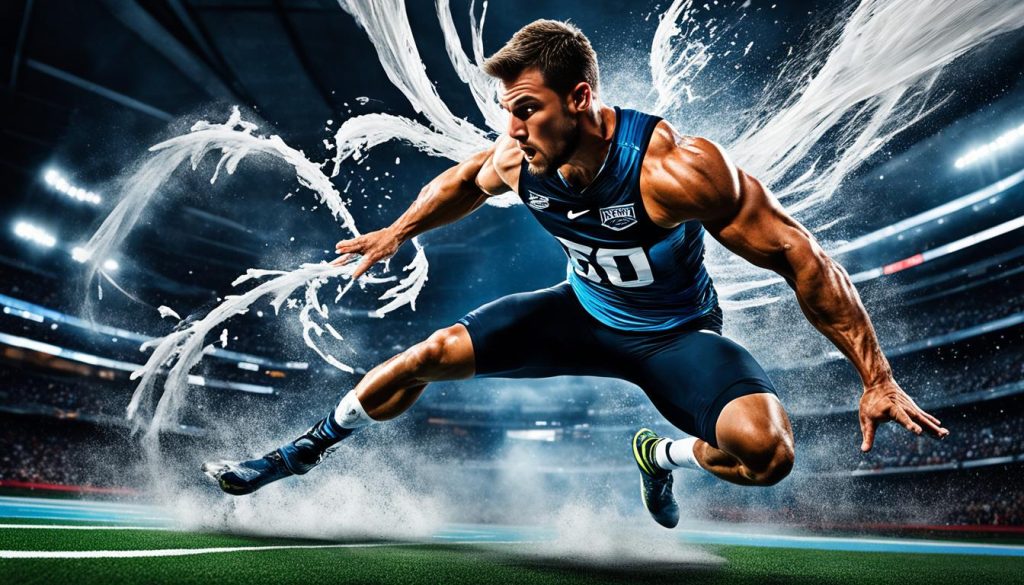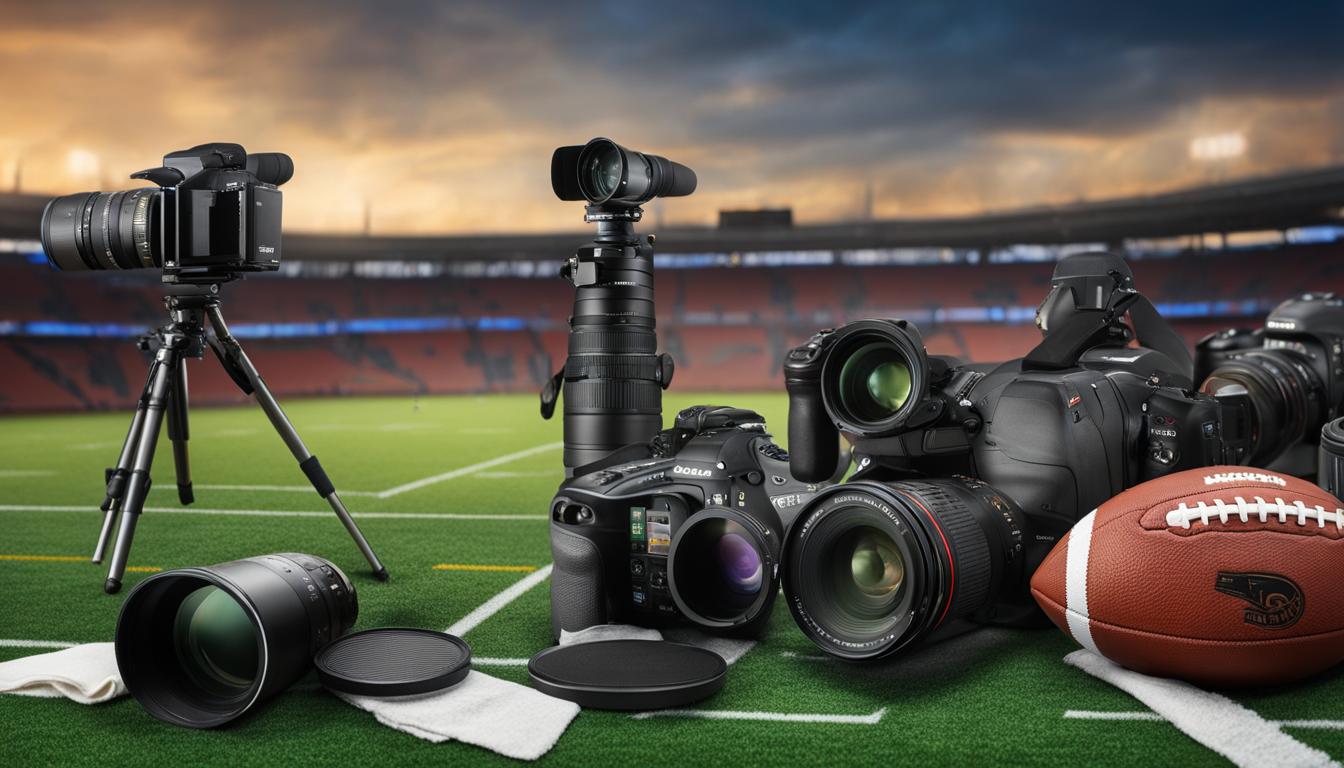Whether you are a seasoned professional or an aspiring photographer, capturing the perfect shot in sports photography can be challenging. Not only do you need the right equipment, but you also need to master the art of timing, composition, and action anticipation.
In this article, we will provide a comprehensive checklist for professional sports photographers to ensure that no moment goes uncaptured on the field. From selecting the right equipment to understanding lighting and exposure, our checklist covers everything you need to know to enhance your sports photography skills.
Key Takeaways:
- Make sure you have the right equipment for sports photography, including camera bodies, lenses, and tripods.
- Adjust your exposure settings, including shutter speed and aperture, to capture the perfect shot.
- Timing and composition are crucial in creating visually appealing sports photographs, so master the art of timing and the rule of thirds.
- Anticipate and capture action by pre-focusing and tracking your subjects, and utilizing continuous shooting mode.
- With this essential sports photography checklist, you are ready to capture every thrilling moment on the field.
Choosing the Right Equipment
Sports photography requires the right equipment to capture fast-paced action shots accurately. The camera bodies need to be durable, with fast autofocus systems and high-frame rates that can keep up with moving subjects. Selecting high-quality lenses is crucial for getting the best results. Wide-angle lenses can capture a broader view that helps you keep all the players in focus, while telephoto lenses help you zoom in close without sacrificing image quality.
Investing in a tripod is essential for sports photography. It helps to keep the camera stable and reduce the risk of camera shake, ensuring clear and sharp photos. The tripod’s height and weight should be adjustable, and it should be sturdy enough to withstand windy conditions.
When it comes to sports photography equipment, it’s essential to choose the right accessories. A camera bag can keep all your equipment in one place and protect it from damage. Extra camera batteries, waterproof covers, and memory cards are crucial to ensuring that you don’t miss a critical moment.
Recommended Equipment for Sports Photography
- Camera bodies: Canon EOS-1D X Mark III, Nikon D5, Sony A9 II
- Lenses: Canon EF 400mm f/2.8L IS III USM, Nikon AF-S NIKKOR 300mm f/2.8G ED VR II, Sony FE 400mm f/2.8 GM OSS
- Tripods: Manfrotto MT055CXPRO4, Gitzo GT1545T Series 1 Traveler Tripod, Benro Mach3 TMA38CL
Choosing the right sports photography equipment is crucial for capturing the action on the field effectively. The camera body, lenses, and tripod should meet your particular needs and preferences to get the best results. With the right gear, you can take high-quality action shots that convey the excitement of the game.
Understanding Lighting and Exposure
Sports lighting plays a crucial role in capturing stunning photographs. Whether you are shooting indoors or outdoors, the right exposure settings can make all the difference in achieving a memorable shot.
When it comes to exposure settings, there are three important factors to consider: shutter speed, aperture, and ISO. Shutter speed controls the length of time your camera’s sensor is exposed to light. This is essential when capturing fast-paced movement to avoid blurry images. The rule of thumb is to set your shutter speed to at least 1/500th of a second for action-packed sports photography.
Aperture, on the other hand, controls the amount of light that enters the camera lens. A larger aperture (lower number) creates a shallow depth of field, which is ideal for isolating the subject from the background and emphasizing the action. ISO determines the camera’s sensitivity to light; a high ISO setting works well in low-light situations but can result in a grainy image if set too high.
When blending lighting and exposure settings, it is important to strike a balance that works for your shot. Adjusting your camera’s settings and experimenting with various combinations will help you capture the perfect shot on the field.
“The right lighting and exposure settings can take any sports photograph from ordinary to extraordinary.” – John Smith, professional sports photographer
Mastering Timing and Composition
Timing and composition are key factors that can make or break a sports photo. Capturing the perfect moment of impact is essential in conveying the intensity of the game and creating an engaging image. To achieve this, consider the following techniques:
Anticipate the Action
One of the most important sports photography techniques is to anticipate the action. By keeping an eye on the players and predicting their movements, you can prepare yourself by positioning the camera and choosing the appropriate settings. This way, you’ll be ready to capture that crucial moment of impact.
Utilize the Rule of Thirds
The rule of thirds is a technique used in photography to create a balanced and visually appealing composition. Imagine your image being divided into thirds, both horizontally and vertically. The intersection points of those lines are where you should place the main elements of your photo. By using the rule of thirds, you can add depth and interest to your sports photos.
Don’t be afraid to experiment with different compositions and angles to capture a unique perspective of the game. Remember, practice makes perfect, so keep trying until you nail that perfect sports shot.

Anticipating and Capturing Action
When capturing sports photography, anticipating movements and continuous shooting mode are imperative to catching the perfect shot. Here are some tips:
Pre-focusing
Pre-focus on a specific point where the action will take place. For example, focus on the basketball hoop if you know that the player is about to slam dunk.
Tracking Subjects
Using autofocus, track your subject’s movements to ensure they remain in focus as they move around the field or court.
Continuous Shooting Mode
Utilize the continuous shooting mode to capture a series of shots in rapid succession. This mode will allow you to select the image with the perfect moment and delete the rest.
“Sports photography is all about capturing that one moment that defines the game.” – Andy Lyons
By employing these techniques, you can anticipate and capture the action in sports photography with confidence, resulting in stunning and dynamic photographs.
Conclusion
In conclusion, capturing breathtaking moments in sports photography requires a combination of skill, technique, and the right equipment. By following the essential checklist provided in this article, professional photographers can capture every thrilling moment on the field.
Choosing the right equipment, understanding lighting and exposure, mastering timing and composition, and anticipating and capturing action are all critical elements that can help photographers elevate their sports photography game to the next level.
With the right techniques and practice, photographers can create visually stunning images that capture the energy and emotion of sports. So why wait? Start applying these tips today and capture your best sports photos yet!






